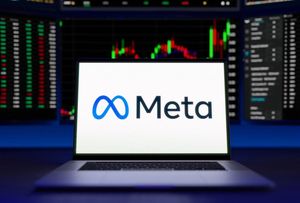
October 20, 2025 – The financial world is witnessing an unprecedented surge in gold prices, with the precious metal shattering previous records and topping an astonishing $4,300 per ounce, even touching $4,365 in recent trading. This meteoric rise, marking an approximate 65-66% gain year-to-date, is not merely a fleeting market anomaly but the culmination of a powerful confluence of global liquidity expansion, strategic central bank policies, and persistent monetary easing across major economies. As investors seek refuge amidst escalating geopolitical tensions and economic uncertainties, gold's traditional role as a safe-haven asset has been dramatically amplified, reshaping portfolio strategies and challenging conventional financial wisdom.
The immediate implications of this gold rush are profound, signaling a significant re-evaluation of risk and value in global markets. Central banks are aggressively diversifying their reserves, private investors are flocking to tangible assets, and the very foundations of the international monetary system are under scrutiny. This sustained upward trajectory suggests a long-term structural shift, rather than a temporary speculative bubble, with forecasts from leading institutions hinting at even higher prices in the coming year, potentially reaching $5,000 to $6,000 per ounce by 2026. The scramble for gold is a clear indicator of a widespread erosion of trust in fiat currencies and traditional financial instruments, underscoring a fundamental "vibe shift" in investor sentiment towards assets that cannot be "printed."
The Unfolding Gold Phenomenon: A Detailed Account
The current gold rally is a multifaceted event, intricately linked to a series of global economic and political developments. At its core, the surge is fueled by an unprecedented expansion of global liquidity, which has surpassed even the peaks observed during the pandemic. This flood of capital, partly driven by substantial monetary stimulus from China and continued accommodative stances in other major economies, provides fertile ground for non-yielding assets like gold to thrive as a store of value. The sheer volume of money circulating in the global financial system naturally seeks outlets, and in times of uncertainty, gold becomes an increasingly attractive destination.
Central banks worldwide have emerged as pivotal players in this gold revolution, engaging in historic levels of accumulation. In 2023, global monetary authorities collectively acquired over 1,037 tonnes of gold, a trend that has not only persisted but intensified throughout 2025. This structural demand is a deliberate strategy to diversify away from US dollar-denominated reserves, motivated by a desire for "sanction-proof" assets and a growing disillusionment with the existing global financial order. Emerging market central banks, in particular, have been vocal about their intentions to further bolster their gold holdings, signaling a long-term commitment to the precious metal.
Further exacerbating the situation is the ongoing monetary expansion spearheaded by major central banks, most notably the Federal Reserve. Anticipation of multiple interest rate cuts through late 2025 and early 2026 has significantly weakened the US dollar. A depreciating dollar makes gold, which is universally priced in the US currency, more affordable and appealing to international buyers, thereby driving up demand. Moreover, lower interest rates diminish the opportunity cost of holding gold, making it a more attractive investment compared to yielding financial instruments. The staggering US national debt, now exceeding $35 trillion, coupled with an elevated debt-to-GDP ratio, fuels concerns about fiscal sustainability and long-term economic stability, further bolstering gold's safe-haven appeal among both institutional and retail investors.
Winners and Losers in the Golden Rush
The unprecedented rise in gold prices creates a distinct landscape of winners and losers within the public markets. Gold mining companies stand to be significant beneficiaries, as higher gold prices directly translate into increased revenues and fatter profit margins. Companies like Barrick Gold Corporation (NYSE: GOLD) and Newmont Corporation (NYSE: NEM) are seeing their stock valuations soar. For Barrick Gold, with operations spanning multiple continents, the increased price per ounce dramatically improves the economics of its existing mines and makes previously marginal projects more viable. Similarly, Newmont, a global leader in gold production, benefits from enhanced cash flow and the potential for increased dividends, attracting more investors. Junior mining companies, often with higher operational costs, also find a new lease on life, with many becoming attractive acquisition targets for larger players.
Conversely, some sectors and companies might face headwinds. Companies heavily reliant on stable, low-cost capital might find borrowing more expensive if the underlying concerns driving gold's rise (like inflation or economic instability) lead to broader market turbulence or shifts in monetary policy. While not direct "losers" in the same vein as those betting against gold, industries that thrive on predictable economic environments and stable currency values might experience indirect negative impacts. Furthermore, some investors who were heavily invested in traditional equity hedges or dollar-denominated assets might find their portfolios underperforming compared to those diversified into precious metals, leading to a rebalancing of capital flows.
Exchange Traded Funds (ETFs) focused on gold and precious metals are also experiencing a boom. The SPDR Gold Shares (NYSEARCA: GLD) and the iShares Gold Trust (NYSEARCA: IAU) have seen substantial inflows, reflecting robust investor demand. These ETFs provide an accessible way for both institutional and retail investors to gain exposure to gold's price movements without the complexities of physical storage or direct futures trading. Their increasing popularity underscores the widespread investor confidence in gold as a strategic asset for hedging against inflation and market volatility. The strong performance of gold is also having a halo effect on other precious metals, with silver ETFs like the iShares Silver Trust (NYSEARCA: SLV) also witnessing dramatic gains in percentage terms, indicating a broader investor appetite for hard assets.
Wider Significance and Historical Context
The current gold surge is more than just a market event; it represents a significant shift in broader industry trends and global economic perceptions. It fits squarely into a narrative of de-dollarization and a re-evaluation of global reserve currencies, a trend that has been simmering for years but is now gaining considerable momentum. The aggressive gold accumulation by central banks, particularly those in emerging economies, signifies a strategic move away from over-reliance on the US dollar, driven by geopolitical considerations and the desire for greater financial autonomy. This shift could have profound ripple effects on the international financial system, potentially altering trade dynamics and capital flows in the long run.
Regulatory and policy implications are also emerging. The sustained rally in gold, fueled by concerns over national debt and monetary expansion, could pressure governments and central banks to re-evaluate their fiscal and monetary strategies. The sheer scale of the US national debt exceeding $35 trillion, coupled with an elevated debt-to-GDP ratio, creates a backdrop of uncertainty that gold thrives on. This situation could lead to increased scrutiny of government spending and a push for more disciplined fiscal policies to restore confidence in fiat currencies. Historically, periods of significant monetary expansion and geopolitical instability have often correlated with strong gold performance, as seen in the 1970s during periods of high inflation and the early 2000s after the dot-com bubble burst and 9/11. The current environment, with its unique blend of factors, echoes these historical precedents but on an even grander scale, suggesting a fundamental recalibration of investor trust.
The event also highlights the potential for a broader "flight-to-quality" across various asset classes. While gold is the primary beneficiary, the increased interest in other precious metals and tangible assets suggests a systemic move by investors to protect wealth from perceived risks in traditional financial instruments. This could lead to a re-allocation of capital across portfolios, potentially impacting the performance of equities, bonds, and other investment vehicles that are seen as less resilient to economic turbulence or currency debasement. The sustained rally in gold is a clear indicator that a significant portion of the market is anticipating continued instability and is positioning itself accordingly.
What Comes Next: Navigating the Golden Horizon
Looking ahead, the short-term outlook for gold remains bullish, though some analysts caution about potential for short-term corrections given the rapid ascent to "overbought" territory. However, any pullbacks are widely viewed as buying opportunities by savvy investors and central banks, who are committed to increasing their gold exposure. In the short term, market participants will be closely watching for further announcements from central banks regarding interest rate policies, particularly from the Federal Reserve, as well as any significant shifts in geopolitical tensions. Continued monetary easing and a weaker dollar are expected to provide a strong tailwind for gold.
In the long term, the structural bull run for gold is anticipated to continue, with forecasts extending well beyond the current record highs. The underlying drivers—global liquidity, central bank diversification, and macroeconomic uncertainties—are deeply entrenched and show no signs of abating. This presents significant market opportunities for investors seeking to hedge against inflation and currency debasement. Gold mining companies may continue to see robust performance, and precious metals ETFs will likely remain popular investment vehicles. However, challenges may also emerge, such as increased regulatory scrutiny on the precious metals market or potential shifts in global economic power dynamics that could alter demand patterns.
Potential strategic pivots for investors and institutions include further diversification of portfolios to include a higher allocation to gold and other hard assets. Companies involved in gold exploration and production might see increased investment and M&A activity as larger players seek to expand their reserves and production capacity. Potential scenarios range from a continued steady ascent of gold prices, driven by persistent demand and ongoing economic anxieties, to more volatile periods marked by sharp corrections followed by renewed rallies. The overarching theme, however, is that gold is likely to remain a cornerstone asset in a world grappling with fiscal challenges and geopolitical flux.
A Comprehensive Wrap-Up: Gold's Enduring Significance
The current surge in gold prices to record highs in 2025 is a powerful testament to the metal's enduring role as a safe haven and a store of value in times of profound economic and geopolitical uncertainty. The key takeaways from this event are clear: global liquidity is at unprecedented levels, central banks are aggressively accumulating gold as a strategic reserve asset, and ongoing monetary expansion, particularly from the Federal Reserve, is weakening the US dollar and making gold more attractive. These intertwined factors have created a formidable bullish environment for gold, pushing its price beyond previously imagined thresholds.
Moving forward, the market is poised for continued interest in gold and other precious metals. Investors are increasingly acknowledging a "vibe shift" in global finance, where trust in traditional fiat currencies and government fiscal management is slowly eroding. This fundamental change in perception underpins the sustained demand for gold, positioning it as a critical component of diversified portfolios. The performance of gold mining companies like Barrick Gold (NYSE: GOLD) and Newmont Corporation (NYSE: NEM), along with popular ETFs such as SPDR Gold Shares (NYSEARCA: GLD), will be closely watched as indicators of market sentiment and the health of the precious metals sector.
The lasting impact of this gold rally is likely to be a more diversified global reserve system and a re-evaluation of investment strategies that prioritize tangible assets and hedges against systemic risk. Investors should continue to monitor central bank policies, global liquidity trends, and geopolitical developments, as these will be the primary drivers of gold's trajectory in the coming months and years. While short-term volatility is always a possibility, the fundamental forces propelling gold to new heights appear deeply entrenched, suggesting that the golden era is far from over.
This content is intended for informational purposes only and is not financial advice






